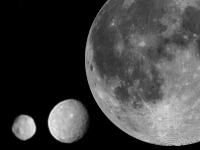Mining of Ceres

The dwarf planet Ceres has been proposed[1] as one possible target for asteroid mining in the inner Solar System.
Physical conditions[edit]
Ceres is a dwarf planet in the asteroid belt, constituting about one third of the mass of the whole asteroid belt and being the sixth-largest body in the inner Solar System by mass and volume. It has a round shape, and a surface gravitational acceleration about 2.8% that of Earth. It has ammonia-rich clay soils [2], a surface area approximately 1.9% of Earth's dry land slightly larger than the total land area of Argentina. Observations indicate that it contains large amounts of water ice,[3][4] about one-tenth of the total water in Earth's oceans. The solar irradiance of 150 W/m2 at aphelion, one ninth that on Earth, is high enough for solar-power facilities.[1]
Strategic location[edit]
Being the largest body in the asteroid belt, Ceres could become the main base and transport hub for future asteroid mining infrastructure,[1] allowing mineral resources to be transported to Mars, the Moon, and Earth.
Because of its small escape velocity combined with large amounts of water ice, it also could serve as a source of water, fuel, and oxygen for ships going through and beyond the asteroid belt.[1] Transportation from Mars or the Moon to Ceres would be even more energy-efficient than transportation from Earth to the Moon.[5]
Potential difficulties[edit]


Because Ceres is not known to have a magnetic field, it is not shielded from cosmic rays or other forms of radiation. Additionally, Ceres does not have a significant atmosphere. The low levels of solar insolation relative to Mars may also affect colonization. Ceres is roughly twice as far from the Sun as Mars (2.56–2.97 AU vs. 1.38–1.67 AU), so solar collectors must have four times the surface area to produce the same power level as on Mars (inverse square law). On the other hand, Ceres rotates much more quickly than Mars (9 hr vs 24.6 hr), so the need for night-time energy storage is less.[6]
The delta-v budget requirement for reaching Ceres from Earth is somewhat higher than what is necessary to reach Mars, however as demonstrated by the Dawn mission, it is feasible to enter Ceres orbit using only ion propulsion. Finally, the surface gravity on Ceres is roughly 2.8% that on Earth (0.27 m/s2 on Ceres vs. 9.807 m/s2 on Earth), which leads to concerns about the negative health effects of long-term weightlessness.
| The surface of Ceres |
|---|

|
See also[edit]
References[edit]
- ↑ 1.0 1.1 1.2 1.3 Lewis, John S. (2 Feb 2015). Asteroid Mining 101.
|access-date=requires|url=(help) Search this book on
- ↑ "Ammonia-rich clays lead to rethink on origins of Ceres". Cosmos Magazine. Retrieved 3 January 2016.
- ↑ Bjorn Carey. Largest Asteroid Might Contain More Fresh Water than Earth
- ↑ Thomas, P. C.; et al. (2005). "Differentiation of the asteroid Ceres as revealed by its shape". Nature. 437 (7056): 224–226. Bibcode:2005Natur.437..224T. doi:10.1038/nature03938. PMID 16148926.
- ↑ Template:PDFlink
- ↑ Williams, David R. (2004). "Asteroid Fact Sheet". Archived from the original on 18 January 2010.
This article "Mining of Ceres" is from Wikipedia. The list of its authors can be seen in its historical. Articles copied from Draft Namespace on Wikipedia could be seen on the Draft Namespace of Wikipedia and not main one.



